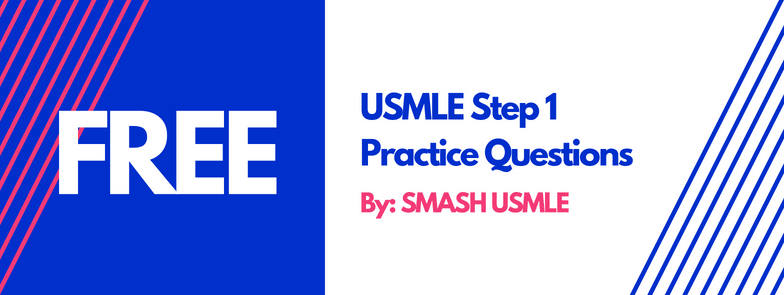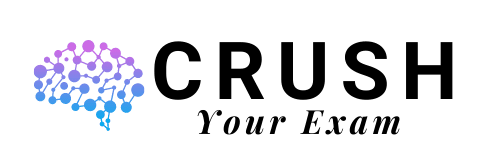

FREE USMLE Step 1 Practice Questions
Are you considering taking the United States Medical Licensing Examination (USMLE) Step 1? If so, you probably know that it’s important to get as much practice as possible before the big day. One way to do this is by working through free USMLE Step 1 practice questions.
But where can you find high-quality practice questions that will help you prepare for the exam? Here are a few options to consider:
-
The USMLE website: The official USMLE website offers a number of free practice questions that cover a variety of topics tested on the Step 1 exam. These questions are written by the same team that creates the actual exam, so you can be confident that they are representative of the types of questions you will see on test day.
-
Online study guides: There are a number of online study guides that offer free USMLE Step 1 practice questions as part of their comprehensive review materials. These questions are often accompanied by detailed explanations and references, which can help you learn more about the concepts being tested.
-
Flashcard apps: There are several flashcard apps that offer free USMLE Step 1 practice questions as part of their study materials. These apps can be a convenient way to review on the go and track your progress over time.
No matter which source you choose, it’s important to work through as many practice questions as possible in order to get a feel for the types of questions you will encounter on the exam. By doing so, you can improve your test-taking skills and increase your confidence on exam day. Good luck!
FREE USMLE Step 1 Practice Exams
Here are 50 free USMLE Step practice test from the Smash USMLE Step 1 question bank.
A 30-year-old primigravid femaleat 16 weeks' gestation comes to the physician for a routine prenatal examination. She has no pre-existing medical conditions and thus far her pregnancy has been uncomplicated. She currently takes prenatal vitamins and iron supplements. Vitals reveal a blood pressure of 160/110 mm Hg. Urinalysis reveals 3+ proteinuria. The most likely cause of these findings is A 42-year-old female comes to the emergency department with shortness of breath and palpitations. An ECG is obtained which reveals sustained ventricular arrhythmias which are found to be unresponsive to several medications. The attending physician finally prescribes bretylium. Bretylium works by A 50-year-old male comes to the physician complaining of neck masses that have been increasing in size for the past six months. He denies having any fevers or night sweats. Physical examination revealsbilateral, nontender cervical lymphadenopathy and hepatosplenomegaly. Biopsy of a cervical node reveals architectural distortion of the lymph node with proliferation of enlarged germinal follicles. Flow cytometry reveals a predominant cell population of CD10+, CD19+ and CD20+ cells. The most likely cause of these findings is A 25-day-old male is brought to the physician due to seizures, rigidityand frequent viral infections. Physical examination reveals a neonate with cyanosisin the lower extremities. The most likely cause of these findings is a A 35-year-old female comes to the physician due toheadaches of two months’ duration. She has no history of pre-existing medical illnesses. Vital signs are within normal limits. A head CT revealsa mass above the left petrous bone and biopsy reveals a malignant schwannoma on the left trigeminal nerve. The patient undergoes surgery for resection of the mass. If there is damage to the involved nerve during the surgery, there will be A 24-year-old female comes to the physician due tourinary frequency and burning with urination. She is diagnosed with a urinary tract infection and prescribed ciprofloxacin. The exposure of a fetus to ciprofloxacin can result in A 45-year-old male who has a BMI of 42 kg/m²undergoes a myocardial perfusion scintigraphy due to frequent chest pain during strenuous activities. An angiogram had earlierrevealed a 95% occlusion in the proximal segment of his left circumflex coronary artery. There were no changes in the othercoronary arteries. The most likely other finding in this patient is A 45-year-old female comes to the physician with joint pain, swelling and morning stiffness which improves with use. She also reports weight loss of 3 kg (6.6 lbs). Laboratory tests reveals the presence of serum rheumatoid factor.The most likely other finding in this patient is A study is conducted by researchers to determine the mechanism of action of a newly isolated hormone. Previous studies have shown that the hormone increases gene expression of growth-inducing proteins. The hormone also appears to be lipophilic and is produced upon demand rather than being stored in cell vesicles. This hormone most likely activates A 30-year-oldCaucasian male with HIV/AIDS develops right-sided weakness involving hisright leg. A MRI of his brain revealsmultiple ring enhancing lesions within the white matter in his left frontal lobe. The most likely source of this infection in the United States is A 2-year-oldmaleis brought to the physician due to mental retardation. Physical examination reveals a single palmar crease, flat face and prominent epicanthal folds. The most likely cause of these findings is A 35-year-old male comes to the physician due to fatigue. He recently returned from a trip to Japan. Laboratoryresults are as follows: Hemoglobin 9 g/dL A peripheral blood smear is obtained which reveals enlarged red blood cells and hypersegmented neutrophils. If these findings were caused by an infection, the most likely source of the infection is via An 18-month-old male is brought to the physician due tomental retardation andabdominal distention. Physical examination reveals enlargement of the liver and spleen. Fundoscopy reveals a cherry red spot on the macula. The most likely other finding in this patient is increased levels of A 1-week-old maleis brought to the emergency department by his mother due to persistent crying and bloody diarrhea. She says he was delivered at 33 weeks’ gestation and has been bottle-fed since then. Physical examination reveals a rigid abdomen. The neonate undergoes emergency surgery to resect a portion of his small intestine during which bowel perforation is confirmed. Microscopic examination of the excised bowel will most likely reveal A 6-year-old maleis broughtto the physician due to asore throat, fever and malaise. Physical examination reveals an erythematous tongue and a sandpaper-like body rash.This most likely sequelae of this infection includes all of these except A 2-week-oldmale is brought to the physician by his mother due to labored breathing for the past day. She had a home delivery which she reports as uneventful but sayshe developed "pink-eye" after thefirst week. Vitals reveal a respiratory rate of 40/min. Physical examination reveals bilateral inspiratory crackles and faint wheezingin both lungs. Laboratory studies reveal a leukocyte count of 15,000/mm³ with 10% A 12-year-old female is brought to the physician by her mother due to a severe sore throat. She has significant pain with swallowing and generally feels tired. Her motheralso reports that the patient has had a high fever for the past four days. Physical examination revealsan erythematous patch on the upper posterior pharynx and tenderness of the cervical lymph nodes. Vitals reveals a temperature of 39.5°C (103.1°F). The nerve responsible for this patient's throat pain is also involved in A 2-year-old female is brought to the physician by her mother who says her face turns blue when she cries. She also has trouble keeping up with her older brother when they play outside. An echocardiogram is obtained which reveals an anterosuperior displacement of the infundibular septum. The most likely diagnosis is A 27-year-old male comes to the physician with skin lesions as shown in the exhibit. Physical examination reveals soft tissue crepitus and the smell of decomposing tissue. The most likely cause of these findings can also cause infection through A 3-year-oldmale is brought to the physician due to an enlarging abdominal mass. Physical examination reveals a mass in the left abdomen that does not cross the midline. Ophthalmic examination is unremarkable. Microscopic examination of a biopsy specimen from the abdomen reveals dense immature islands of epithelial cells, ribbons of spindle fibroblastic stromal cells and poorly formed tubular structures. The most likely diagnosis? A 40-year-old male is brought to the emergency department due to progressive memory loss, confusion, and urinary incontinence.Laboratory studies reveala CD4 cell count of 25/mm³. A MRI reveals moderate brain atrophy. Although the patient is admitted for treatment he eventually dies of disseminated aspergillosis. Microscopic examination of an autopsy specimen from hisbrain shows multifocal lymphohistiocytic infiltrates with numerous microglial nodules and scattered multinucleated giant cells. His histologic and MRI findings were most likely caused by A 5-month-oldmale is brought to the physician by his parents due to twitching of his facial muscles. Review of his medical records reveals that he has previously been treatedfor several episodes of Candidainfections. Physical examination reveals low set ears, hypertelorismand a shortened philtrum. The most likely additional finding in this patient is A 50-year-old male is brought to the emergency department due to an acute onset chest pain that radiates to his jaw. An ECG revealsST segment elevation in leads II, III and aVF. He undergoes percutaneous coronary intervention with stenting without any complications. The patient is discharged from the hospital three days later withaspirin and clopidogrel. He returns to the emergency department eight weeks later due to recurrent chest pain which he describes as a sharp pain that worsens when he lies flat. The pain does not radiate or improve with nitroglycerin tablets. Vitals reveal a blood pressure of 135/87 mm Hg, a heart rate of 84/min, a temperature of 38.0°C (100.5°F) and a respiratory rate of 12/min. Oxygen saturation is 98% on room air. Physical examination revealsa harsh three component extra heart sound heard best at the left lower sternal border. An ECG is obtained which reveals diffuse ST elevations. The most likely cause of the current findings is A9-month-oldmale is evaluated for lactic acidosis and increased levels of serum alanine. He is diagnosed with pyruvate dehydrogenase complex deficiency and placed on a special diet by the physician.This special diet most likely consists of A 35-year-old male comes to the physician due to fatigue. He recently returned from a trip to Japan. Laboratoryresults are as follows: Hemoglobin 9 g/dL A peripheral blood smear is obtained which reveals enlarged red blood cells and hypersegmented neutrophils. These findings were most likely caused by A 15-year-old femaleis brought to the physician by her mother because she is concerned that she has not started menstruating. Physical examination reveals the patient's vagina is very shallow without a palpable uterus. There are also palpable masses in the labia majora. Karyotype analysis reveals a 46, XY genotype. Which of the following was most likely present during the early fetal life of this patient? A 17-year-oldfemale is brought to the emergency department by her parents dueto right foot pain. She denies recent trauma and has no history of major illnesses. She is physically active and walks for at least one hour daily. She says that she is doing well in high school and gets along well with her parents except that they keep tellingher to eat more especially since her boyfriend broke up with her a year ago.Vitals reveal a weight 47.6 kg (105 lbs) and BMI of16 kg/m². The most likely diagnosis is 1 A 2-hour-old female who is born at 37 weeks' gestation has purple patches on her skin as well as hepatosplenomegalyand jaundice. A CT of the head is obtained which reveals periventricular calcifications. The most likely cause of these findings is also responsible for A 19-year-old female is brought to the emergency department after she collapsed while jogging. She has a history of anorexia nervosa. When she regains consciousness, she says as she was jogging she became lightheaded, broke out into a sweat, and had palpitations. Her fingerstick glucose is 40 mg/dL. Her palpitations and diaphoresis were most likely caused by A 35-year-old male comes to the physician due to fatigue. He recently returned from a trip to Japan. Laboratoryresults are as follows: Hemoglobin 9 g/dL A peripheral blood smear is obtained which reveals enlarged red blood cells and hypersegmented neutrophils. The most appropriate pharmacologic treatment for this patient is with A 45-year-old female comes to the physician with joint pain, swelling and morning stiffness which improves with use. She also reports weight loss of 3 kg (6.6 lbs). Laboratory tests reveals the presence of serum rheumatoid factor. Before prescribing etanercept, the physician should obtain a A 61-year-old male is admitted to the hospital with worsening shortness of breath and fatigue. Physical examination reveals dullness to percussion and decreased breath sounds in the right lung. A chest x-ray is obtained which reveals a large right-sided pleural effusion. Thoracentesis yields 250 mL of fluid with a pleural fluid protein/serum protein ratio of 0.7 and a lactate dehydrogenase level of 240 U/L. The most likely diagnosis is A 50-year-old malewho is a known alcoholic is brought to the emergency department by police. He complains of a productive cough with thick, bloody sputum. Vitals reveal atemperature of 38°C (100.4 °F). Physical examination reveals dullness to percussion, increased tactile fremitus and decreased breath sounds over the right lung fields. A chest radiograph is obtained which reveals consolidation inthe right upper lobe. The most likely cause of these findings is a A 2-year-old female is brought to the physician by her mother who says her face turns blue when she cries. She also has trouble keeping up with her older brother when they play outside. An echocardiogram is obtained which reveals an anterosuperior displacement of the infundibular septum. The most important determinant of her prognosis is the A 65-year-old malewho had a cholecystectomy at a local hospital experiences nausea and vomiting two days later. He is prescribed metoclopramide by the resident physician. Metoclopramide is contraindicated in patients with A 34-year-old female comes to the physician with nausea and abdominal pain. She indicates that the pain is epigastric and it improves with food intake. She also reports recent weight gain. A urease breath test is obtained which is positive.The most likely cause of these findings has all the following characteristics except A 35-year-old male comes to the physician due towatery diarrhea of two weeks’ duration. He also has a low-grade fever, fatigue and weight loss of 5kg (11 lbs) over thepast month. Laboratory findings include a CD4+ T cell count 70 cells/mm³. To find the cause of his diarrhea, the next best step is a test involving A 35-year-old male comes to the physician due towatery diarrhea of two weeks’ duration. He also has a low-grade fever, fatigue and weight loss of 5kg (11 lbs) over thepast month. Laboratory findings include a CD4+ T cell count 70 cells/mm³. The most likely diagnosis is A 65-year-oldfemalewith end stage renal failurecomes to her physician with a rash and is diagnosed with Lyme disease. Review of her medical records reveals severe allergic reactions to penicillin and macrolides. The most appropriate treatment for this patient’s current disease is A 40-year-old male comes to his physician due to progressive muscle weakness and paralysis. Over the next few years, his condition progresses to complete paralysis of all voluntary muscles and he eventually dies of respiratory failure. Microscopic examination of tissue obtained at autopsy shows that both upper and lower motor neurons are degenerated. Of the listed options, the location which would likely reveal the most marked neuronal loss is the A 60-year-old male with a past medical history of hyperlipidemia and hepatic dysfunction comes to the physician for a routine examination. He states that he has had difficulty initiating urination for the past seven months with an intermittent urine stream and urinary urgency. Vitals reveal a blood pressure of 150/90 mm Hg,a heart rate of 65/min, a temperature of 37.0°C (98.6°F) and a respiratory rate of 12/min. Digital rectal examination reveals diffuse enlargement of the prostate. The most appropriate pharmacologic treatment for this patient is most likely a drug that A 50-year-old male with AIDS develops a fever, headache and stiff neck. A sample of his cerebrospinal fluid reveals the presence of lymphocytes, glucose levels of 35 mg/dL and protein levels of 75 mg/dL. The test which would most likely confirm this patient’s diagnosis is the A 34-year-old female comes to the physician with nausea and abdominal pain. She indicates that the pain is epigastric, and it improves with food intake. She also reports recent weight gain. A urease breath test is obtained which is positive.This patient is most likely at an increased risk for developing A 55-year-oldfemale comes to the physician with a dry cough of three weeks’ duration. The cough is not associated with sputum or blood production and she is afebrile. She has a medical history of rheumatoid arthritis, peptic ulcer disease and hypertension for which is receiving treatment. The most likely cause of her chief complaint is A 45-year-old maleis broughtto the emergency department by the police who found him wandering around a park at midnight. Physical examination reveals bilateral hand tremors. Laboratory tests reveal elevated serum gamma-glutamyltransferase. Thirty hours after he is admitted to the hospital he developsgeneralized seizures. The most appropriate treatment for this patient’s seizures is A 24-year-old female comes to the physician due tourinary frequency and burning with urination. She is diagnosed with a urinary tract infection and prescribed ciprofloxacin. The mechanism of action of ciprofloxacin is by A 30-year-oldfemaleis brought to the emergency department after being involved in a motor vehicle accident. She was not wearing a seatbelt and was ejected from her car seat upon collision with a tree. Physical examination reveals several lacerations on her face and chest as well as an inability to open her mouth against resistance.The muscle which was most likely injured is the A 45-year-old female comes to the physician because of headaches and palpitations. Vitals reveal a blood pressure of 190/140 mm Hg and a heart rate of 105/min. A CT scan of the abdomen is obtained which reveals an adrenal mass. The hormones secreted by the adrenal mass are derived from A 40-year-old malecomes to the emergency department due to a two-week history of a productive cough that is occasionally associated with blood. He has had similar episodes in the past. Vitals reveal a blood pressure of 140/80 mm Hg, a heart rate of 75/min, atemperature of 37.6°C (99 6°F) and a respiratory rate of 16/min.Oxygen saturation is 90% on room air. Laboratory results are as follows: Complete blood count The most likely other finding in this patient’s serum is A group of research scientists are studying immunohistochemical stains used for detecting the different types of cell. The stain which is used to detect epithelial cells is
Loading...
Correct!
Wrong!
Correct!
Wrong!
Correct!
Wrong!
Correct!
Wrong!
Correct!
Wrong!
Correct!
Wrong!
Correct!
Wrong!
Correct!
Wrong!
Correct!
Wrong!
Correct!
Wrong!
Correct!
Wrong!
Mean corpuscular volume 108 fl
MCHC 33 g/dL
Mean corpuscular hemoglobin 35 pg
Correct!
Wrong!
Correct!
Wrong!
Correct!
Wrong!
Correct!
Wrong!
Correct!
Wrong!
Correct!
Wrong!
Correct!
Wrong!
Correct!
Wrong!
Correct!
Wrong!
Correct!
Wrong!
Correct!
Wrong!
Correct!
Wrong!
Correct!
Wrong!
Mean corpuscular volume 108 fl
MCHC 33 g/dL
Mean corpuscular hemoglobin 35 pg
Correct!
Wrong!
Correct!
Wrong!
Correct!
Wrong!
Correct!
Wrong!
Correct!
Wrong!
Mean corpuscular volume 108 fl
MCHC 33 g/dL
Mean corpuscular hemoglobin 35 pg
Correct!
Wrong!
Correct!
Wrong!
Correct!
Wrong!
Correct!
Wrong!
Correct!
Wrong!
Correct!
Wrong!
Correct!
Wrong!
Correct!
Wrong!
Correct!
Wrong!
Correct!
Wrong!
Correct!
Wrong!
Correct!
Wrong!
Correct!
Wrong!
Correct!
Wrong!
Correct!
Wrong!
Correct!
Wrong!
Correct!
Wrong!
Correct!
Wrong!
Correct!
Wrong!
Hemoglobin 11.8 g/dL
Hematocrit 35.4%
Mean Corpuscular Volume 85 µm³
Leukocytes10,000/mm³
Differential:
Neutrophils 60%
Bands 3%
Lymphocytes 25%
Monocytes 7%
Eosinophils 3%,
Liver function studies
Alanine aminotransferase 15 U/L
Aspartate aminotransferase 90 U/L
Serum chemistry
Creatinine 1.5 mg/dL
Blood urea nitrogen 23 mg/dL
Urinalysis2+ blood, red blood cell casts
Correct!
Wrong!
Correct!
Wrong!
Share the quiz to show your results !
Subscribe to see your results
I got %%score%% of %%total%% right
Here is my revised and optimized version of the page:
Get Access to FREE USMLE Practice Questions
Getting quality USMLE practice questions is key for exam preparation. This page provides free samples from top USMLE question banks to help you get an idea of what to expect on test day.
What is the USMLE?
The United States Medical Licensing Examination (USMLE) is a three-step exam required for medical licensure in the United States. It assesses an examinee’s understanding of and ability to apply concepts and principles that are important in health and disease.
The USMLE is sponsored by the Federation of State Medical Boards (FSMB) and the National Board of Medical Examiners (NBME). It is divided into 3 Steps:
- Step 1 – Assesses whether you understand and can apply important concepts of the sciences basic to the practice of medicine. Step 1 is taken after the second year of medical school.
- Step 2 CK – Focuses on whether you can apply medical knowledge, skills, and understanding of clinical science essential for the provision of patient care under supervision. Taken during fourth year of medical school.
- Step 3 – Measures whether you can apply medical knowledge and understanding of biomedical and clinical science essential for the unsupervised practice of medicine. Typically taken during first year of residency.
Access Free USMLE Practice Questions
Below we’ve compiled free sample questions from the most popular USMLE question banks. This will allow you to get exposure to different question styles and difficulty levels to better prepare for the exam.
Free USMLE Step 1 Questions
Step 1 focuses on the basic sciences and is arguably the most difficult part of the exam. Try out these Step 1 practice questions:
Kaplan Qbank
Amboss Qbank
United States Medical Licensing Examination
Free USMLE Step 2 CK Questions
Step 2 CK is more clinically focused. Try out these practice questions:
Kaplan Step 2 CK Qbank
United States Medical Licensing Examination
Lecturio Step 2 CK
Free USMLE Step 3 Questions
Step 3 assesses clinical knowledge for unsupervised medical practice:
United States Medical Licensing Examination
Kaplan Qbank
Summary
Getting exposure to USMLE practice questions is an important part of exam preparation. Start with these free samples from Kaplan, UWorld, and Amboss to get familiar with the content style and difficulty.
Practice questions are one of the best ways to improve test performance. Be sure to use a comprehensive Qbank in your studies to fully prepare for the breadth of topics tested on the USMLE.




